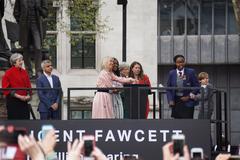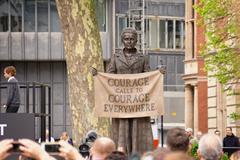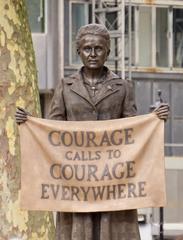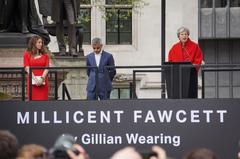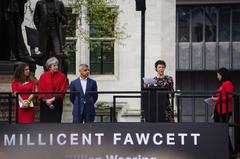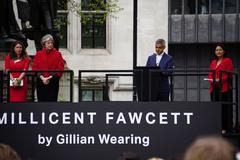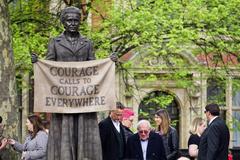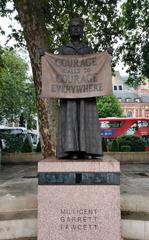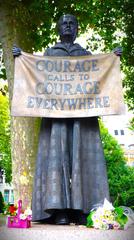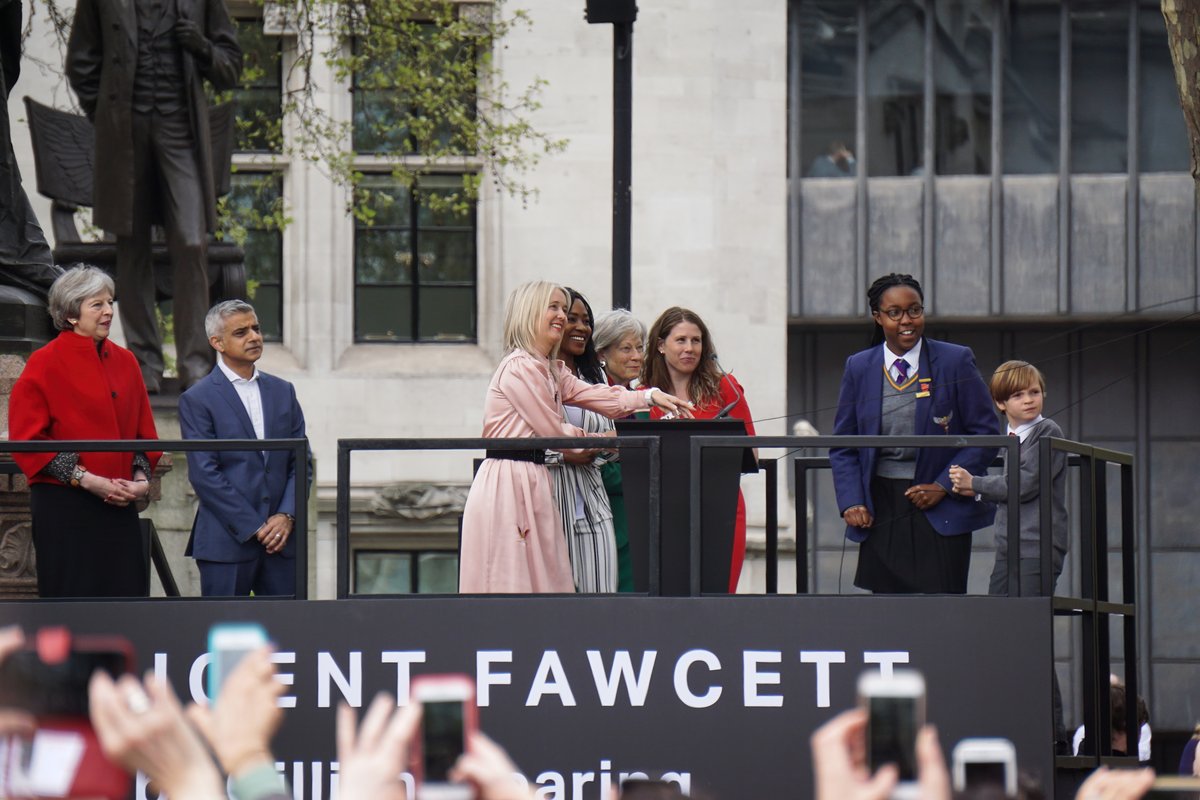
Statue of Millicent Fawcett: Visiting Hours, Tickets, and London Historical Sites Guide
Date: 14/06/2025
Introduction
The Statue of Millicent Fawcett, unveiled in 2018 in London’s Parliament Square, marks a transformative moment in the city’s historical landscape. As the first statue of a woman—and the first by a female artist—in this prominent public space, it celebrates Dame Millicent Garrett Fawcett’s pivotal leadership in the British women’s suffrage movement. This comprehensive guide covers the statue’s history, significance, artistic symbolism, visitor information, accessibility, guided tours, travel tips, and its ongoing cultural impact.
For more background and planning resources, see BBC News, Historic England, and The Independent.
Table of Contents
- Origins and Campaign for the Statue
- Millicent Fawcett: Life and Legacy
- Artistic Design and Symbolism
- Visiting the Statue: Hours, Location, and Accessibility
- Guided Tours and Nearby Attractions
- Photographic Tips and Best Times to Visit
- Special Events and Cultural Impact
- Recent Events and Public Reception
- Frequently Asked Questions (FAQ)
- Conclusion and Visitor Tips
- References
Origins and Campaign for the Statue
The push for the Millicent Fawcett statue began in 2016 when activist Caroline Criado Perez noticed the lack of female representation in Parliament Square. Her campaign quickly gained momentum, collecting nearly 85,000 signatures and securing cross-party political support (BBC News; Historic England). Funding came from the UK government’s Centenary Fund, marking 100 years since the Representation of the People Act 1918 (UK Government). The campaign chose Millicent Fawcett to highlight the importance of constitutional, peaceful activism in the suffrage movement (iNews).
Gillian Wearing OBE, a Turner Prize-winning artist, was selected to create the statue—the first female artist to have a permanent work in Parliament Square (Fawcett Society).
Millicent Fawcett: Life and Legacy
Dame Millicent Garrett Fawcett (1847–1929) led the National Union of Women’s Suffrage Societies (NUWSS) and campaigned for women’s rights through peaceful means. Her advocacy contributed to the passage of the Representation of the People Act 1918, which first granted British women the right to vote, and the Equal Franchise Act 1928, which extended equal voting rights to all women over 21 (BBC News; Statues for Equality; National Archives).
Fawcett also founded Newnham College, Cambridge, and led humanitarian investigations during the Boer War. Her enduring legacy is that of a pioneering feminist and advocate for peaceful, democratic reform.
Artistic Design and Symbolism
Gillian Wearing’s bronze statue depicts Fawcett at age 50, the year she became NUWSS president. She holds a banner reading, “Courage calls to courage everywhere,” a quote from a 1913 speech in tribute to Emily Davison (London Remembers; Wikipedia).
The statue stands on a granite plinth engraved with the names and portraits of 59 suffrage campaigners—both women and men—honoring the collective nature of the movement (Statues for Equality). Wearing’s realistic style, period attire, and inclusion of a brooch (copied from Fawcett’s own) evoke both the humanity and dignity of her subject.
Positioned to face the Houses of Parliament, the statue symbolically confronts the seat of political power, urging ongoing progress for gender equality (BBC News).
Visiting the Statue: Hours, Location, and Accessibility
Location: Parliament Square, Westminster, London SW1P 3BD.
Visiting Hours: The statue is in an open public space and accessible 24 hours a day, every day of the year. No tickets or reservations are required.
Accessibility: Parliament Square is wheelchair-accessible, with paved surfaces and step-free access. The nearest Tube station is Westminster (Jubilee, District, and Circle lines), which offers step-free access. Public toilets, including accessible facilities, are nearby.
Admission: Visiting the statue is free.
Guided Tours and Nearby Attractions
Many walking tours of Westminster and Parliament Square include the Millicent Fawcett statue, often alongside visits to:
- Houses of Parliament and Big Ben
- Westminster Abbey
- Churchill War Rooms
- Supreme Court of the United Kingdom
- London Eye
These attractions are all within a short walking distance and provide a broader context for understanding British history and democracy.
Photographic Tips and Best Times to Visit
- Best Lighting: Early mornings and late afternoons provide softer light and fewer crowds.
- Photography: Capture the statue with the Houses of Parliament as a backdrop for a classic London image.
- Details: Don’t miss photographing the plinth’s engraved portraits and the banner inscription.
Special Events and Cultural Impact
The statue is a focal point for events on International Women’s Day, suffrage anniversaries, and feminist campaigns. The surrounding garden beds often feature red, white, and green flowers, reflecting the suffragists’ colors (London Remembers).
The statue has inspired public debate about representation in public art and serves as an educational resource for schools and community groups (Sheffield University).
Recent Events and Public Reception
Since its unveiling on 24 April 2018, the statue has been celebrated as a breakthrough for female representation in public spaces. It stands alongside icons like Churchill and Mandela, underscoring women’s contributions to British democracy (BBC News; Historic England).
In June 2025, the statue was defaced during a protest over trans rights and the legal definition of “woman,” drawing renewed attention to its ongoing relevance in debates about gender and equality (BBC News; The Independent).
Frequently Asked Questions (FAQ)
Q: Are tickets required to visit the statue?
A: No. The statue is outdoors and freely accessible at all times.
Q: What are the best hours for visiting?
A: The statue is open 24/7. Early mornings and weekends are quieter and ideal for photos.
Q: Is the site accessible to visitors with disabilities?
A: Yes. The area is step-free, paved, and suitable for wheelchairs and mobility aids.
Q: Are guided tours available?
A: Yes. Many Westminster walking tours feature the statue as a highlight.
Q: Can I take photographs?
A: Yes. Photography is encouraged.
Q: What other attractions are nearby?
A: Westminster Abbey, the Houses of Parliament, Churchill War Rooms, and the London Eye.
Conclusion and Visitor Tips
The Statue of Millicent Fawcett stands as both a work of art and a living symbol of the progress toward gender equality. Its presence in Parliament Square invites all visitors to reflect on the power of peaceful activism and the ongoing importance of representation in public life. Plan your visit to this landmark and enrich your experience by exploring the surrounding historical sites, joining a guided tour, and engaging with resources like the Audiala app.
Stay updated on events and news through trusted platforms such as BBC News and The Independent.
References and Further Reading
- BBC News, 2018, “Historic statue of suffragist leader Millicent Fawcett unveiled in Parliament Square”
- Historic England, 2018, “Case study: Millicent Fawcett statue”
- The Independent, 2018, “Millicent Fawcett statue unveiled in Parliament Square”
- Wikipedia, 2023, “Statue of Millicent Fawcett”
- London Remembers, 2018, “Millicent Fawcett Statue”
- Statues for Equality, 2020, “Millicent Fawcett”
- UK Government, 2018, “Historic statue of suffragist leader Millicent Fawcett unveiled in Parliament Square”
- iNews, 2018, “Millicent Fawcett statue: The campaign to put a woman in Parliament Square”
- HuffPost UK, 2018, “Millicent Fawcett statue unveiled in Parliament Square”
- SCCI: Women and Men Honoured by Suffragist Statue
- Heritage Calling: The First Woman in Parliament Square
- HistorianRuby: London’s Millicent Fawcett Statue
- Evendo: Millicent Garrett Fawcett Statue
Image Suggestions:
- High-quality image of the statue with the Houses of Parliament in the background (alt: “Statue of Millicent Fawcett holding banner ‘Courage calls to courage everywhere’”)
- Close-up of the plinth’s engraved portraits (alt: “Engraved portraits on Millicent Fawcett statue plinth”)
- Map of Parliament Square highlighting the statue’s location
- Virtual tour links or embedded videos of the statue and surrounding landmarks
For related information, see our guides on “Women’s Suffrage Movement in the UK,” “Monuments in Parliament Square,” and “Top Historical Sites to Visit in London.”
